Serviços Personalizados
Artigo
Indicadores
Links relacionados
-
 Citado por Google
Citado por Google -
 Similares em Google
Similares em Google
Compartilhar
Stellenbosch Papers in Linguistics Plus (SPiL Plus)
versão On-line ISSN 2224-3380
versão impressa ISSN 1726-541X
SPiL plus (Online) vol.62 Stellenbosch 2022
http://dx.doi.org/10.5842/62-0-900
ARTICLES
Phonological and morphological influences on vowel hiatus resolution in Rutooro
Lee Bickmore
Department of Anthropology, University at Albany, USA; Department of Linguistics and Language Practice, University of the Free State, Bloemfontein, South Africa E-mail: lbickmore@albany.edu
ABSTRACT
When the morphology of a language creates instances of successive vowels, these cases of vowel hiatus are often resolved or repaired. This paper presents a wide variety of instances where vowel hiatus is created within verbs in Rutooro, a Ugandan Bantu language. It is shown that five different strategies are employed to resolve vowel hiatus: deletion, gliding, diphthongisation, epenthesis, and lexical allomorphy. While some of these processes are largely phonological, there are a number of morphological factors which also play a role in determining which of the various strategies are employed. All of these are explored and discussed.
Keywords: Rutooro; phonology; vowel hiatus; allomorphy; epenthesis; gliding
1. Introduction
Rutooro is a Bantu language spoken by approximately half a million speakers in Western Uganda. Other closely related languages include Luganda, Runyankore, Ruciga, Nyoro, Soga, and Gwere. Previous work on the language includes a Runyooro-Rutooro grammar (Rubongoya 1999), a Rutooro dictionary (Kaji 2007), several papers on tone (Kaji 2009, 2010, 2018; Clemens and Bickmore forthcoming), one paper on vowel harmony (Bickmore 2019a), and one on liquid consonant realisation (Bickmore 2019b). This paper adds to this growing body of literature by describing and analysing vowel hiatus resolution in the language. New data will be presented, showing that Rutooro employs no less than five different strategies to resolve vowel hiatus. In the course of robustly documenting each strategy, I identify the phonological as well as morphological factors that determine how any single hiatus instance gets resolved.1
The vowel and consonant inventories of Rutooro are given below in (1) and (2). I employ a practical orthography, where any deviations from the phonetic alphabet are indicated within the consonant chart. The language exhibits a vowel length contrast which will be indicated orthographically by double vowels. While the language exhibits surface tone on the penultimate syllable of phonological phrases, there is no underlying tone contrast. As tone does not interact with vowel resolution in any way, I do not indicate it here. (It does play a role in distinguishing different types of relative constructions in section 4, and will be indicated in that context.)

We will see that Rutooro employs multiple strategies to resolve vowel hiatus. As our focus in this paper will be the resolution of hiatus within verbs, it is crucial to understand the various elements within a verb, where the morphology can create VV sequences. The basic morphological structure of the Rutooro verb is given in (3).

As is true in many Bantu languages, it is not the case that all five vowels are attested in the morphemes appearing in each of these morphological categories. As one example, while all of these (except the Final Vowel) can be vowel-initial or consonant-initial, that characteristic can limit which vowels can occur. This is summarized below.
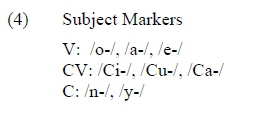
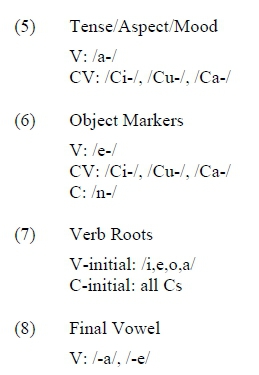
As seen above, all Subject Markers are maximally monosyllablic. Only three are onsetless: the 2 sg /o-/, the Class 1 /a-/, and the Class 4 and Class 9 /e-/. Most of the rest of the Subject Markers are of the shape CV, where the V is either a high or low vowel (the mid vowels are not attested in this environment). The 1 sg Subject Marker is a nasal /n-/ which will undergo homorganic place assimilation to a following consonant. The /y-/ is a lexical allomorph of the Class 1 Subject Marker, motivated and discussed in section 3.
Of the language's various TAM prefixes, only one is onsetless: the Past /a-/. The rest are of the shape CV and, like Subject Markers, only contain high or low vowels.
Object Markers are also generally of the shape CV, again with either high or low vowels. As in many Bantu languages, Rutooro has a reflexive prefix (in this case /e-/) which always shows up in the same position as (and cannot co-occur with) Object Markers.
Roots can be either vowel- or consonant-initial. In general, any vowel or consonant can be root-initial, the sole exception being (/u/), which is never found root-initially.
The Final Vowel can be either /-a/ or /-e/.
2. Illustration of various hiatus contexts
Let us now systematically examine cases where a VV sequence is created through morphological affixation within the Rutooro verb. We will see that one important factor with respect to how these sequences get resolved is whether the first V belongs to an onsetless morpheme /V/ or an onsetful one /CV/. We begin by considering the latter case.
In the case of /CV-V/ hiatus, where the vowels are identical, the surface result is a long (bimoraic) vowel, regardless of the morphological juncture within the verb. Representative examples are given below.

In each case, the second V gets syllabified into the immediately preceding CV, forming a bimoraic syllable. I discuss these forms again further below and suggest an analysis.
Next, let us consider cases where the two vowels in /CV-V/ hiatus are different. We begin by looking at cases where the first vowel is [+hi]. As seen below, in such cases the first vowel glides, inducing compensatory lengthening (CL) in the second vowel. This occurs in all morphological contexts.

Next, let us consider what happens when the first vowel in /CV-V/ is [-hi]. First, we note that, as shown in (4)-(6) above, the only non-high vowel that actually occurs in /CV-/ prefixes is /a/. When /a/ is followed by the vowel /i/, diphthongisation occurs, as shown below. (The orthographic <ai> sequence represents the diphthong [aI].)

When the vowel following /Ca-/ is not /i/, then the first vowel (/a/) deletes, inducing CL on the following vowel, as shown below. This occurs in all morphological contexts.
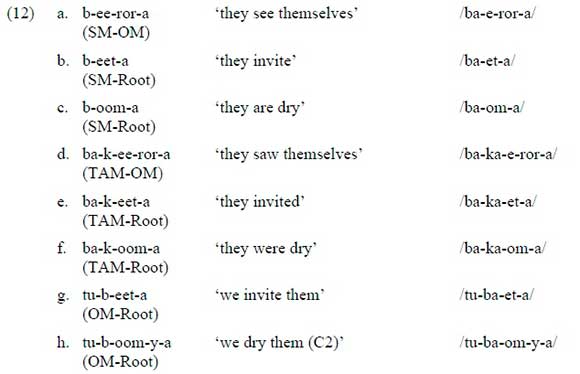
We now turn to cases where the first V in the hiatus does not have a tautomorphemic onset, i.e., cases where the first vowel is a full morpheme /V/. As seen in (4)-(6) above, such cases in Rutooro are limited to the non-high vowels /e-/, /o-/, and /a-/. In the hiatus context /V-V/, when the second V is /i/, diphthongisation occurs, as it did in (11). (The orthographic <ei> and <oi> sequences represent the diphthongs [eI] and [oI], respectively.)

In /V-V/ hiatus contexts, when the second vowel is not /i/, then the palatal glide [y] is epenthesized between the two vowels. In this case, the second vowel will be either /e/, /o/, or /a/, as /u/ is never morpheme-initial ((4)-(7)).
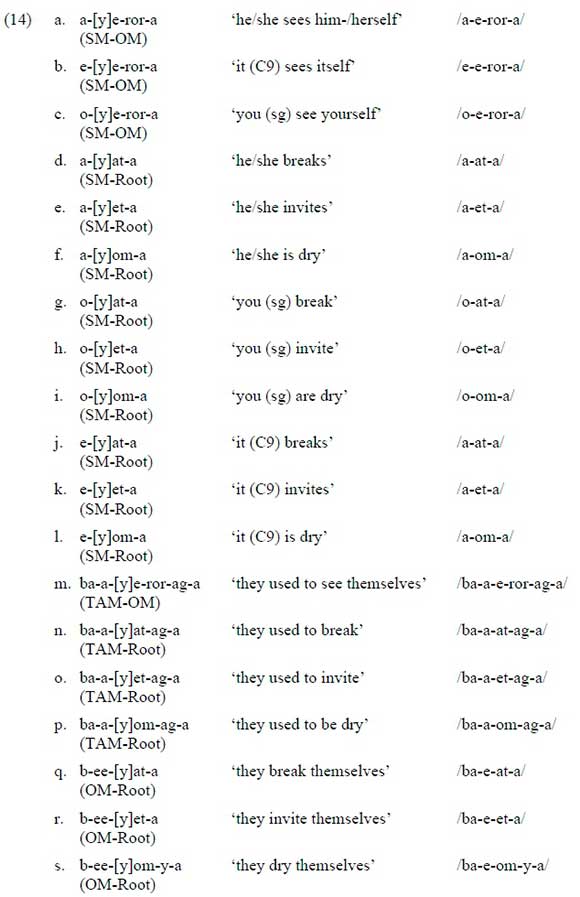
As can be seen, [y] is inserted between the two vowels in /V-V/ hiatus (when the second V ≠ /i/), across all morphological contexts, whether the two vowels are identical or not.2 This /V -V/ pattern is different from the patterns we saw above for /CV-V/ cases, where two identical vowels simply fused (9), and for non-identical vowels, where the first [-hi] vowel underwent vowel deletion (12).
I note here that epenthesis can occur multiple times when its structural description is met, as seen in the examples below.

In each case, there is a sequence of three underlying vowels, where the first two are onsetless (i.e., each constitutes its own morpheme). In such cases, epenthesis will occur twice.
I now summarize the patterns we have seen thus far and begin to formulate an analysis. First, whenever the first V is [-hi] and the second V is /i/, diphthongisation occurs. This is true whether the first V has an onset (11) or not (13). Next, if the first vowel is [+hi], it will glide (10). (There are no such cases where the first vowel is onsetless due to the underlying patterns in the language, e.g., (4)-(6).) Where we find a marked difference in the behaviour of /CV-V/ cases and /V-V/ ones is where the first V is [-hi] and the following V is something other than /i/. When the first V is onsetful, it deletes, as in (12), whereas if it is onsetless, glide epenthesis occurs, as in (14). One possible analysis of this would be to simply make the presence or absence of an onset part of the structural description of the rule. But that suggests that the relationship between having an onset and whether that vowel gets deleted or not is random. However, we know of no language, e.g., where the reverse happens - i.e., where an onsetless vowel deletes but an onsetful one triggers glide epenthesis. Thus, we propose that what is driving this difference is a prohibition on the total segmental deletion of a morpheme. Therefore, vowel deletion, the preferred hiatus resolution method for these sequences, can apply in forms such as those in (12), where the deletion of the first vowel leaves behind the immediately preceding C of that morpheme, but it will not apply in (14), as vowel deletion would erase the entire morpheme. As the hiatus must still ultimately be resolved, another repair strategy comes into play, namely glide insertion. Avoiding the deletion of an entire morpheme has been proposed as a factor operating in other languages. Casali (1997), for example, analysed such cases in OT with a Max-Monosegmental constraint, and Kurisu (2001) did so with a Realize-Morph constraint.
Given this claim, I briefly return to the forms in (9) where both underlying Vs in the /CV-V/ hiatus were identical. One possible analysis of this would be to posit a fusion process whereby adjacent identical vowels fuse into one long vowel. While that might work for the forms in (9), it would run afoul in forms such as those below in (16).

As can be seen in (16), these two adjacent identical vowels do not fuse. Rather, glide epenthesis resolves the hiatus. We can account for both the cases in (9) as well as the one in (16) by analysing the former as instances of vowel deletion, as exhibited in (12). If ordered after gliding and diphthongisation, we can formalise vowel deletion in a maximally simple way as the deletion of the first vowel in any /...V-V.../ sequence (i.e., regardless of whether the first vowel has on onset within the morpheme or not). The rule will not apply in (16) as it would result in the complete deletion of a morpheme. It will correctly apply in all the examples in (9) since deletion of the first vowel does not result in the deletion of a morpheme.
Finally, in the data analysed up to this point, what seems to trigger a resolution process in Rutooro are instances of vowel hiatus, and not simply onsetless syllables. For example, word-initial onsetless syllables are generally freely tolerated, as seen in (10h,j) and (13)-(15). There is, however, one instance in which a word-initial onsetless syllable does get an onset via glide epenthesis. This happens in imperatives which begin with a vowel, as illustrated below. (In the case of (17d), I assume a separate overriding process prohibiting *yi sequences, unattested in the language.)

3. Realisation of SMs of shape /V/
Let us now examine in greater depth how some morphemes of the shape /V/ are realised. Specifically, I will focus on the Subject Markers noted in (4). Let us begin with the 2 sg Subject Marker /o-/. Its realisation in a variety of different environments is shown below.
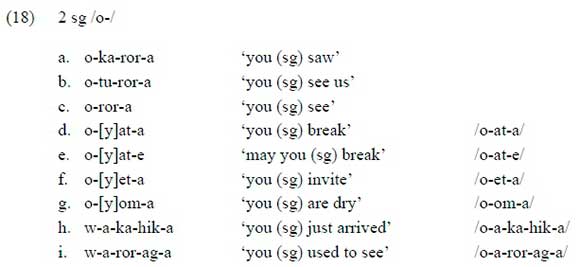
When this SM is followed by a consonant, it is realised as [o], as seen in (18a-c). When /o/ is followed by a vowel, however, two different hiatus resolution strategies are seen. If the following vowel belongs to the verb root, then epenthesis occurs (18d-g), but if the following vowel is the TAM prefix /a-/, then gliding occurs (18h,i). Thus, we see the direct influence of morphology in the choice of strategy here, as the same phonological /o-a/ sequences in (18d,e) are resolved differently than those in (18h,i).
The role of morphology in the determination of the hiatus resolving strategy is even more pronounced when the 2 sg SM is followed by the reflexive prefix /e-/. As seen below, this /o-e/ sequence is resolved by epenthesis in the Habitual tense (signalled by a null TAM prefix and the Final Vowel /-a/) and by gliding in the nearly segmentally identical Subjunctive (signalled by a null TAM prefix and the Final Vowel /-e/).

Thus, while it might be possible to explain the difference between the epenthesis in (18d-g) and the gliding in (18h,i) as being conditioned by the particular morpheme that follows the 2 sg SM, i.e., a root versus a TAM prefix, such an approach is not possible in (19), where the morpheme following the SM is identical in the two cases (the reflexive). Here, the choice between hiatus resolution strategies must in part be based on the TAM of the verb, even though in this case the TAM prefix is null for both forms. The other option would be to have the choice be based on the Final Vowel, which would entail non-local conditioning.
Let us now turn to an examination of the Class 4 and Class 9 SMs, both set up as underlying /e-/. (As they are both realised identically in the same environment, we choose to gloss the examples below as Class 9 'it'.) As seen below, these forms exhibit the exact same hiatus resolution patterns seen in the 2 sg SM forms detailed above.
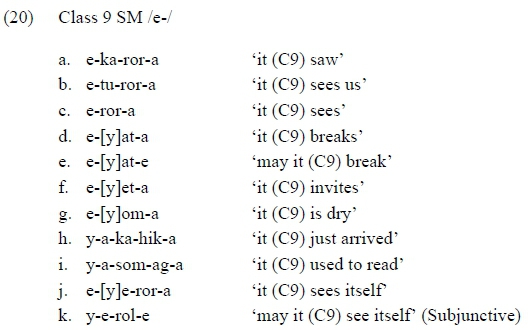
Before a consonant, the Class 9 (as well as the Class 4) SM is realised as [e] (20a-c). Before a root vowel, it is also realised as [e] and triggers epenthesis (20d-g). Before the TAM prefix /a-/, it glides to [y] (20h,i). Before the reflexive /e-/, it triggers epenthesis in the Habitual (20j), but glides in the Subjunctive (20k). (Cf. (19).)
Finally, let us examine the Class 1, 3 sg SM. As shown below, it is sometimes realised as [a] and sometimes as [y].
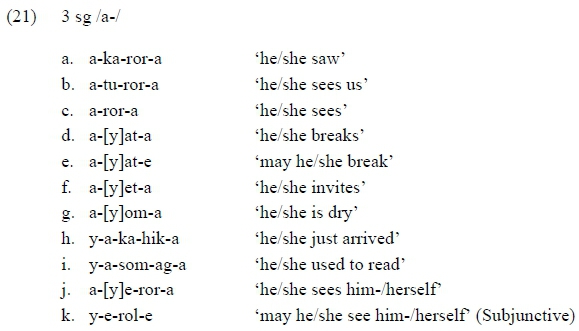
Before a consonant, the 3 sg is realised as [a] (21a-c). As was the case with the other two /V/-shaped SMs, before a vowel-initial root, it triggers y-epenthesis (21d-g). Before the TAM prefix /a-/ (21h,i) and before the reflexive prefix /e-/ in the Subjunctive (21k), the 3 sg SM is realised as [y]. As was seen above, the 2 sg /o-/ and Class 4/9 /e-/ are realised as [w] (19) and [y] (20) respectively in the pre-V environments. For those cases, I propose a gliding process, positing that both high and mid vowels productively glide before another vowel. Positing gliding in the case of the 3 sg /a-/, however, seems problematic. Under standard assumptions about vowel and glide features, it is a straightforward process to derive [w] from /u/ and /o/ and [y] from /i/ and /e/ through demorification of the first vowel. Simply demorifying /a/ does not straightforwardly yield [y]. I therefore suggest that the 3 sg SM has two lexical allomorphs: /y/ in the environments shown in (21h,i,k) and /a-/ elsewhere. This kind of allomorphy of the 3 sg SM is not unusual in Bantu. For example, in Cilungu, a Zambian Bantu language, the 3 sg SM is /u-/ before a V-initial TAM prefix, otherwise /a-/ (Bickmore 2007).
I noted above that both high vowel gliding (10) and vowel deletion (12) were accompanied by a process of CL, preserving the input mora count, a process not uncommon in Bantu. The morphologically conditioned Mid Vowel Gliding, however, does not trigger CL as seen in (18h,i), (19b), and (20h,i,k). Two possible solutions present themselves. One possible analysis would be to simply prohibit CL when the demorified V does not have an onset. This is also the case in other closely related languages such as Luganda (Hyman and Katamba 1999). A second possibility would be to prohibit CL when the demorified V is [-hi]. While either approach works for these forms, we will examine additional data below to support the former. Finally in this regard, we note that since CL itself is triggered by the reassociation of a mora which has been set afloat either due to vowel deletion or gliding, we correctly predict the absence of vowel lengthening following an epenthesized glide, as seen in (14), (15), and (17), or the /y-/ allomorph of the 3 sg SM (21h,i,k).
To summarize thus far, here are the processes being posited:


Only the processes in (22c,e) trigger CL. Three sample derivations illustrating some of these processes are given below.

4. Relative verb forms
Let us now turn finally to relative verb forms, which provide additional contexts for vowel hiatus resolution. Relative verb forms in Rutooro all have both "full" and "reduced" realisations. (See Clemens and Bickmore (forthcoming) for more on this.) These are illustrated below (IV = Initial Vowel; acute accent indicates High tone; accentless vowel indicates Low tone).
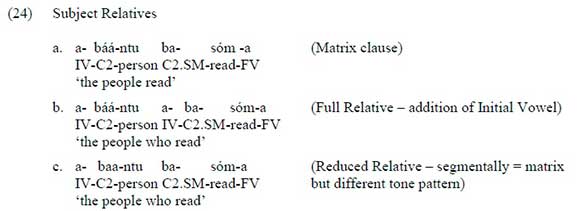
The verb form in (24a) is the one appearing in a matrix clause. It begins with a subject DP and is followed by a verb (in this case the Habitual), where the SM agrees in class with the preceding subject. The form in (24b) is a full relative. The verb differs from the one in the matrix clause by the addition of an Initial Vowel. The second type of relative clause - the "reduced" one in (24c) - does not have the Initial Vowel, rendering it segmentally (and tonally) identical to the verb in the matrix clause in (24a). (Depending on the TAM, the reduced relative and matrix verb forms can be segmentally distinct.) While tangential to our present concerns regarding hiatus, I note that the overall tone patterns of the entire phrases in (24a) and (24c) are in fact different due to prosodic phrasing (examined in detail in Clemens and Bickmore (forthcoming)).
Object Relatives are presented in (25).
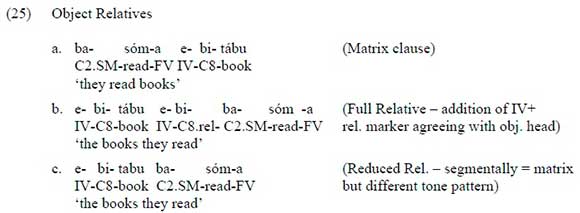
The phrase in (25a) is a matrix clause where the verb is followed by a DP object. The full relative form is presented in (25b). The phrase begins with an object head followed by the verb which contains both the Initial Vowel as well as a relative prefix which agrees in class with the object head. In (25c), the reduced form is presented, which has neither of the two additional prefixes found in the full form, rendering it segmentally identical to the verb in the matrix clause in (25a). The morphology of all five verb forms is summarized in (26).

The phonological form of the Initial Vowel is generally a [-hi] version of the vowel in a CV Subject Marker, as illustrated in the headless relative clauses in (27) below.

Having reviewed the morphological structure of relative forms, let us now examine cases of hiatus. We begin with full subject relatives, one agreeing with a Class 9 head and the other with a Class 1, shown below.


Each of these forms presents issues not yet accounted for. First, in both (28a,b), the SM surfaces as long unexpectedly. In all cases above seen to this point, glide epenthesis never induces CL. We do not expect it to as no mora is added to the form. The unexpected long vowels in (28) can actually lead to minimal pairs of verb forms such as the relative in (28a), meaning 'it (C9) who sees', and the matrix form e-[y]e-ror-a (20j), meaning 'it (C9) sees itself. This could be accounted for (though admittedly unintuitively) by epenthesizing a full vowel (/i/,/u/) to resolve hiatus between an IV and a following SM. Otherwise, CL would be morphologically conditioned just in this context.
(28b) is odd in two additional respects. First, while the SM is the low vowel /a/, the IV, generally a [-hi] copy of the V in the SM (27), is /o/. Let us remember, however, that the IV also appears in nouns, as evident in the phrases in (24) and (25). In nearly every class, the vowel in the SM and in the nominal class prefix is identical, and the IV is a [-hi] copy of that vowel. The one exception is Class 1. The SM, as we noted above, is /a-/ (realised as /y-/ before TAM prefix /a-/ (21)) but the Class 1 noun class prefix is /mu-/, triggering /o-/ as the IV, e.g., o-muu-ntu 'person', o-mu-limi 'farmer'. Thus, relative clauses such as the one in (28b) seem to be evidence that the IV for Class 1 is always /o-/, even though in this case it is followed by the 3 sg SM /a-/ which has a low vowel.
Finally, (28b) is the one morphological environment in the language where [w], rather than [y], is epenthesized to resolve hiatus. Specifically, between the IV and a following /V/, the inserted vocoid must agree in rounding with the IV. By contrast, when the first V is not the IV, [y] is epenthesized, even when the first V is /o/ (cf. (14g-i)).
Continuing to examine subject relatives where the SM is either Class 4/9 or Class 1, let us consider the following forms which contain the Past /a-/ TAM prefix.

In (29a), the Class 9 SM is underlyingly /e-/ and glides before the Past TAM /a-/ (cf. (20h,i)). In (29b), the /y-/ allomorph is chosen before the Past TAM /a-/ (cf. (21h,i)). The IV in (29b) surfaces as /a-/ before the 3 sg SM /a-/. This is in contrast to the form in (28b) where the IV surfaced as /o-/. It is not obvious how to account for this outside of direct morphological conditioning. Finally, with respect to CL, we predict such will not occur in (29b) since the UR of SM is the lexical allomorph /y-/. In (29a), the Class 4/9 SM is moraic (/e-/) but, as with the comparable matrix forms (20h,i,k), no CL occurs. As noted above in the discussion of (18) and (20), this can be accounted for by positing that only the gliding of onsetful vowels triggers CL.
Finally, let us turn to hiatus contexts in full object relatives. Recall from (25) that full object relatives in Rutooro are marked with two prefixes: a relative agreement prefix (which immediately precedes the SM and agrees with the object head) preceded by an IV. Below in (30), we show object relatives with a /CV/ SM.
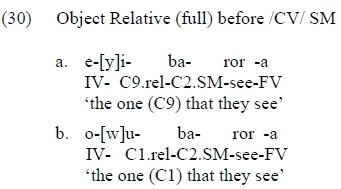
The relative verb form in (30a) refers to an object head which is in Class 9, triggering the Class 9 relative agreement marker /i/. We see that epenthesis applies between the relative agreement marker and the IV, which is /e-/. In (30b), the Class 1 relative agreement marker is /u-/ and the IV is /o-/. As noted above for (28b), the epenthesized glide after an IV must agree with that IV in rounding, accounting for the [w]. No CL occurs. We note here that these seem to be the only /V/-shaped morphemes in the verbal morphology that are underlyingly high. As noted above, all /V/-shaped subject (4) and object (6) prefixes are all [-hi].
Lastly, full object relatives with a /V/-shaped SM are presented below.
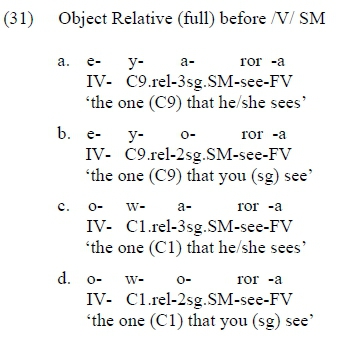
The relative agreement markers /i/ (31a,b) and /u/ (31c,d) both glide before the immediately following /V/-shaped SM. They do not trigger CL of the following vowel. I account for this by positing that the gliding of onsetless morphemes does not trigger CL. (Assuming that CL is not triggered due to the first V being [-hi] might work in forms such as those in (18)-(20), but not for the forms in (31).)
5. Summary
In examining a large array of hiatus contexts in Rutooro verb forms, we have seen that hiatus is resolved in a number of different ways:

I posited that both phonological as well as morphological factors play a role in determining which strategy of hiatus resolution gets employed. These are summarized below. Phonological factors which play a role in determining how vowel hiatus is resolved, and whether CL occurs, are listed in (33).

In addition to these phonological factors, I have noted a number of morphological ones that also play a role in determining how vowel hiatus is resolved. These are listed below in (34).

It is not surprising that both phonological and morphological factors contribute to how hiatus gets resolved. Still, a few patterns seem puzzling. Perhaps the three most idiosyncratic findings in this study are: (i) CL being triggered after glide insertion in subject relatives (28a,b); (ii) the differing hiatus resolution strategies between a /V-/ SM and the reflexive /e-/ prefix in the Habitual and Subjunctive (e.g., (19)); and (iii) the choice of the IV as /a-/ before the /y-/ realisation of the 3 sg SM (29b), as compared to /o-/ in (28b). Additional studies are needed in order to see if there are near or exact parallels to the limited set of unexpected Rutooro patterns in other Bantu languages.
Abbreviations
agr agreement
C# Class #
CL Compensatory Lengthening
FV Final Vowel
IV Initial Vowel
OM Object Marker
pl plural
rel relative
sg singular
SM Subject Marker
TAM Tense/Aspect/Mood
UR Underlying Representation
Acknowledgements
First and foremost, a huge thanks to my Rutooro language consultant, Barbara Balinda, for her time, expertise, and patience. This paper benefitted from fruitful discussions with Katherine Hout, David Odden, Winfred Mkochi, Lauren Clemens, Rod Casali, Larry Hyman, Josephat Rugemalira, Nicholas Rolle, and the audience at the 2020 Workshop of Theoretical Phonology at Concordia University. Finally, I am grateful for the comments of two anonymous reviewers. Any errors or omissions are completely my own.
References
Bickmore, L. 2007. Cilungu phonology. Stanford: Center for the Study of Language and Information. [ Links ]
Bickmore, L. 2019a. Unaltered morphemes as phonological triggers and targets in Rutooro. Journal of African Languages and Linguistics 40(1): 3-22. https://doi.org/10.1515/jall-2019-0002 [ Links ]
Bickmore, L. 2019b. Liquid realization in Rutooro. In E. Clem, P. Jenks and H. Sande (eds.) Theory and description in African linguistics: Selected papers from the 47 th Annual Conference on African Linguistics. Berlin: Language Science Press. pp. 63-74. [ Links ]
Casali, R.F. 1997. Vowel elision in hiatus contexts: Which vowel goes? Language 73: 493-533. https://doi.org/10.2307/415882 [ Links ]
Clemens, L. and L. Bickmore. Forthcoming. The role of attachment height in explaining prosodic phrasing in Rutooro. Natural Language and Linguistic Theory. https://doi.org/10.1007/s11049-020-09492-w
Hyman, L. and F. Katamba. 1999. The syllable in Luganda phonology and morphology. In H. van der Hulst and N. Ritter (eds.) The syllable: Views andfacts. Berlin: Mouton de Gruyter. pp. 349-416. https://doi.org/10.1515/9783110806793.349 [ Links ]
Kaji, S. 2007. A Rutooro vocabulary. Tokyo: Research Institute for Languages and Cultures of Asia and Africa. [ Links ]
Kaji, S. 2009. Tone and syntax in Rutooro, a toneless Bantu language of Western Uganda. Language Sciences 31(2-3): 239-247. https://doi.org/10.1016/Uangsci.2008.12.006 [ Links ]
Kaji, S. 2010. A comparative study of tone of West Ugandan Bantu languages, with particular focus on the tone loss in Tooro. ZAS Papers in Linguistics 53: 33-51. https://doi.org/10.21248/zaspil.53.2010.394 [ Links ]
Kaji, S. 2018. From Nyoro to Tooro: Historical and phonetic accounts of tone merger. In H. Kubozono and M. Giriko (eds.) Tonal change and neutralization. Berlin and Boston: De Gruyter Mouton. pp. 330-349. https://doi.org/10.1515/9783110567502-012 [ Links ]
Kurisu, K. 2001. The Phonology of Morpheme Realization. Unpublished doctoral dissertation, University of California, Santa Cruz. [ Links ]
Rubongoya, L.T. 1999. Modern Runyooro-Rutooro grammar. Köln: Rüdiger Köppe Verlag. [ Links ]
1 All the data presented here were collected from Barbara Kaweesa, a 30-year-old native speaker of Rutooro from Fort Portal, Uganda.
2 I show the epenthesized vowel in square brackets in the surface forms simply as an aid to the reader to quickly identify epenthesized vowels. This distinguishes them from underlying /y/s, such as the second <y> in (14s) and others below. Finally, while they are represented to the right of the morpheme boundary separating the two vowels, this is an arbitrary convenience, as there is no evidence that they become part of one of the two morphemes as opposed to the other.














